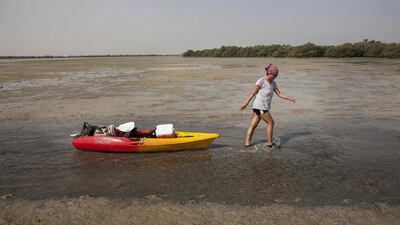UMM AL QUWAIN // “Look – a nappy!”
This is not something you expect to hear when visiting areas of natural beauty.
Yet along the route Zahidah Zeytoun Millie chooses to kayak through Khor Al Beidah lagoon, examples of people’s rubbish litters the white sandy beaches.
Among the dark green tufts of low-lying salt-tolerant shrubs that make up the mangroves are also plastic bottles and plates left over from a recent picnic.
Next to the discarded nappy, a small flower with bright yellow petals – Cistanche tubulosa – is in full bloom.
Later, in her painter’s studio, Zahidah displays watercolour sketches that capture the flower’s gentle beauty.
Her regular visits to the salt water mangroves are a way of admiring nature’s ability to flourish despite people’s waste.
Once a week in the early morning, the 45-year-old sets out in her kayak to paint the lagoon and its mangrove-lined channels to create a snapshot of the area for people who do not get the chance to see it up close – the way bright-green and yellow algae settle on the aerial roots of mangrove trees; the way sunlight reflects off the water and the trees’ dark green foliage.
Zahidah started kayaking through the mangroves as a way of coping with the conflict in her home country of Syria.
“It helped me,” says the painter whose mother and sister still live in the war-torn country. “It gave me great relief away from the bad news.”
As Zahidah kayaks deeper into the mangroves, away from the places that are popular with visitors, the area returns to its natural state.
The water is shallow and clear enough to see large crabs darting underneath stones.
A stingray flashes past before disappearing out of sight. Three large turtles stick their heads above the water to breathe.
Navigating through a narrow channel in low tide, Zahidah’s kayak approaches a mudflat covered by what looks like a carpet of algae with thousands of small gastropods.
In the distance, a flock of flamingos are feeding. Eventually mangrove trees, some as tall as five metres, appear along the banks, the exposed roots home to tiny crabs and schools of small fish.
Surrounded by trees, Zahidah ties her kayak and takes out her brushes and paints.
While most people would call her works landscape paintings, she prefers to call them portraits.
“As a tree, I respect it [the mangrove] because it is a pretty tough tree in a tough environment,” she says.
Zahidah is preparing to exhibit her watercolour sketches and oil paintings in November. She hopes that by showing her work she will encourage more people to value the mangroves and protect them.
Stephanie Neville will also take part in the exhibition.
“The idea is to interact with the environment and show love and care,” says the artist, who first saw the mangroves during a skydive in 2009.
“The first thing that struck me was the contrast of the landscape to what we normally associate with the UAE.”
Besides litter, the area is also impacted by people harvesting the mangrove branches, presumably to feed them to their camels.
Umm Al Quwain municipality did not respond to questions about the refuse problem.
vtodorova@thenational.ae

